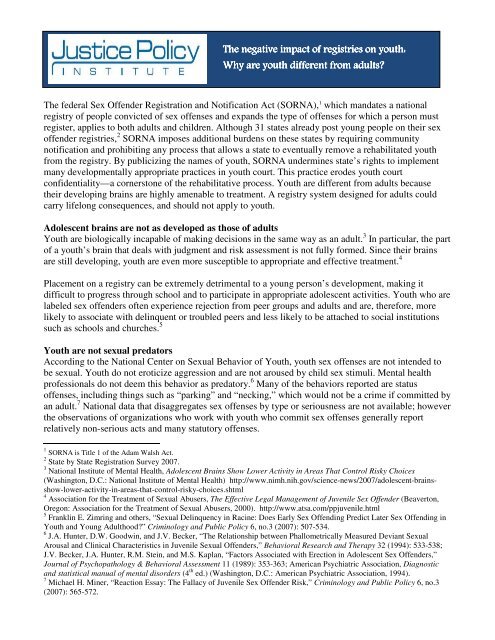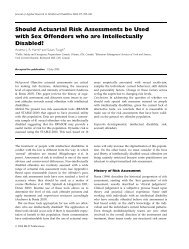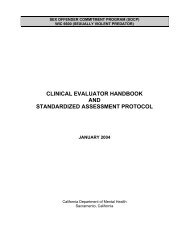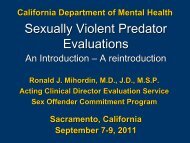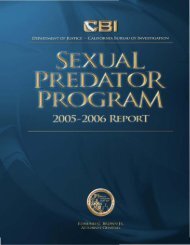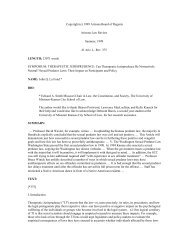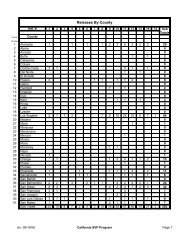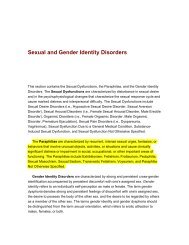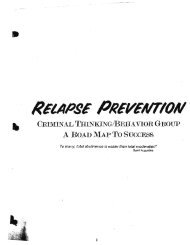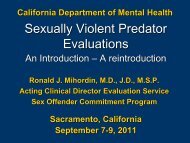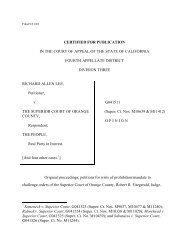The negative impact of registries on youth - Justice Policy Institute
The negative impact of registries on youth - Justice Policy Institute
The negative impact of registries on youth - Justice Policy Institute
You also want an ePaper? Increase the reach of your titles
YUMPU automatically turns print PDFs into web optimized ePapers that Google loves.
<str<strong>on</strong>g>The</str<strong>on</strong>g> <str<strong>on</strong>g>negative</str<strong>on</strong>g> <str<strong>on</strong>g>impact</str<strong>on</strong>g> <str<strong>on</strong>g>of</str<strong>on</strong>g> <str<strong>on</strong>g>registries</str<strong>on</strong>g> <strong>on</strong> <strong>youth</strong>:Why are <strong>youth</strong> different from adults?<str<strong>on</strong>g>The</str<strong>on</strong>g> federal Sex Offender Registrati<strong>on</strong> and Notificati<strong>on</strong> Act (SORNA), 1 which mandates a nati<strong>on</strong>alregistry <str<strong>on</strong>g>of</str<strong>on</strong>g> people c<strong>on</strong>victed <str<strong>on</strong>g>of</str<strong>on</strong>g> sex <str<strong>on</strong>g>of</str<strong>on</strong>g>fenses and expands the type <str<strong>on</strong>g>of</str<strong>on</strong>g> <str<strong>on</strong>g>of</str<strong>on</strong>g>fenses for which a pers<strong>on</strong> mustregister, applies to both adults and children. Although 31 states already post young people <strong>on</strong> their sex<str<strong>on</strong>g>of</str<strong>on</strong>g>fender <str<strong>on</strong>g>registries</str<strong>on</strong>g>, 2 SORNA imposes additi<strong>on</strong>al burdens <strong>on</strong> these states by requiring communitynotificati<strong>on</strong> and prohibiting any process that allows a state to eventually remove a rehabilitated <strong>youth</strong>from the registry. By publicizing the names <str<strong>on</strong>g>of</str<strong>on</strong>g> <strong>youth</strong>, SORNA undermines state’s rights to implementmany developmentally appropriate practices in <strong>youth</strong> court. This practice erodes <strong>youth</strong> courtc<strong>on</strong>fidentiality—a cornerst<strong>on</strong>e <str<strong>on</strong>g>of</str<strong>on</strong>g> the rehabilitative process. Youth are different from adults becausetheir developing brains are highly amenable to treatment. A registry system designed for adults couldcarry lifel<strong>on</strong>g c<strong>on</strong>sequences, and should not apply to <strong>youth</strong>.Adolescent brains are not as developed as those <str<strong>on</strong>g>of</str<strong>on</strong>g> adultsYouth are biologically incapable <str<strong>on</strong>g>of</str<strong>on</strong>g> making decisi<strong>on</strong>s in the same way as an adult. 3 In particular, the part<str<strong>on</strong>g>of</str<strong>on</strong>g> a <strong>youth</strong>’s brain that deals with judgment and risk assessment is not fully formed. Since their brainsare still developing, <strong>youth</strong> are even more susceptible to appropriate and effective treatment. 4Placement <strong>on</strong> a registry can be extremely detrimental to a young pers<strong>on</strong>’s development, making itdifficult to progress through school and to participate in appropriate adolescent activities. Youth who arelabeled sex <str<strong>on</strong>g>of</str<strong>on</strong>g>fenders <str<strong>on</strong>g>of</str<strong>on</strong>g>ten experience rejecti<strong>on</strong> from peer groups and adults and are, therefore, morelikely to associate with delinquent or troubled peers and less likely to be attached to social instituti<strong>on</strong>ssuch as schools and churches. 5Youth are not sexual predatorsAccording to the Nati<strong>on</strong>al Center <strong>on</strong> Sexual Behavior <str<strong>on</strong>g>of</str<strong>on</strong>g> Youth, <strong>youth</strong> sex <str<strong>on</strong>g>of</str<strong>on</strong>g>fenses are not intended tobe sexual. Youth do not eroticize aggressi<strong>on</strong> and are not aroused by child sex stimuli. Mental healthpr<str<strong>on</strong>g>of</str<strong>on</strong>g>essi<strong>on</strong>als do not deem this behavior as predatory. 6 Many <str<strong>on</strong>g>of</str<strong>on</strong>g> the behaviors reported are status<str<strong>on</strong>g>of</str<strong>on</strong>g>fenses, including things such as “parking” and “necking,” which would not be a crime if committed byan adult. 7 Nati<strong>on</strong>al data that disaggregates sex <str<strong>on</strong>g>of</str<strong>on</strong>g>fenses by type or seriousness are not available; howeverthe observati<strong>on</strong>s <str<strong>on</strong>g>of</str<strong>on</strong>g> organizati<strong>on</strong>s who work with <strong>youth</strong> who commit sex <str<strong>on</strong>g>of</str<strong>on</strong>g>fenses generally reportrelatively n<strong>on</strong>-serious acts and many statutory <str<strong>on</strong>g>of</str<strong>on</strong>g>fenses.1 SORNA is Title 1 <str<strong>on</strong>g>of</str<strong>on</strong>g> the Adam Walsh Act.2 State by State Registrati<strong>on</strong> Survey 2007.3 Nati<strong>on</strong>al <strong>Institute</strong> <str<strong>on</strong>g>of</str<strong>on</strong>g> Mental Health, Adolescent Brains Show Lower Activity in Areas That C<strong>on</strong>trol Risky Choices(Washingt<strong>on</strong>, D.C.: Nati<strong>on</strong>al <strong>Institute</strong> <str<strong>on</strong>g>of</str<strong>on</strong>g> Mental Health) http://www.nimh.nih.gov/science-news/2007/adolescent-brainsshow-lower-activity-in-areas-that-c<strong>on</strong>trol-risky-choices.shtml4 Associati<strong>on</strong> for the Treatment <str<strong>on</strong>g>of</str<strong>on</strong>g> Sexual Abusers, <str<strong>on</strong>g>The</str<strong>on</strong>g> Effective Legal Management <str<strong>on</strong>g>of</str<strong>on</strong>g> Juvenile Sex Offender (Beavert<strong>on</strong>,Oreg<strong>on</strong>: Associati<strong>on</strong> for the Treatment <str<strong>on</strong>g>of</str<strong>on</strong>g> Sexual Abusers, 2000). http://www.atsa.com/ppjuvenile.html5 Franklin E. Zimring and others, “Sexual Delinquency in Racine: Does Early Sex Offending Predict Later Sex Offending inYouth and Young Adulthood?” Criminology and Public <strong>Policy</strong> 6, no.3 (2007): 507-534.6 J.A. Hunter, D.W. Goodwin, and J.V. Becker, “<str<strong>on</strong>g>The</str<strong>on</strong>g> Relati<strong>on</strong>ship between Phallometrically Measured Deviant SexualArousal and Clinical Characteristics in Juvenile Sexual Offenders,” Behavioral Research and <str<strong>on</strong>g>The</str<strong>on</strong>g>rapy 32 (1994): 533-538;J.V. Becker, J.A. Hunter, R.M. Stein, and M.S. Kaplan, “Factors Associated with Erecti<strong>on</strong> in Adolescent Sex Offenders,”Journal <str<strong>on</strong>g>of</str<strong>on</strong>g> Psychopathology & Behavioral Assessment 11 (1989): 353-363; American Psychiatric Associati<strong>on</strong>, Diagnosticand statistical manual <str<strong>on</strong>g>of</str<strong>on</strong>g> mental disorders (4 th ed.) (Washingt<strong>on</strong>, D.C.: American Psychiatric Associati<strong>on</strong>, 1994).7 Michael H. Miner, “Reacti<strong>on</strong> Essay: <str<strong>on</strong>g>The</str<strong>on</strong>g> Fallacy <str<strong>on</strong>g>of</str<strong>on</strong>g> Juvenile Sex Offender Risk,” Criminology and Public <strong>Policy</strong> 6, no.3(2007): 565-572.
<str<strong>on</strong>g>The</str<strong>on</strong>g>re have been numerous stories publicized in the media <str<strong>on</strong>g>of</str<strong>on</strong>g> <strong>youth</strong> as young as age 6 being labeled asex <str<strong>on</strong>g>of</str<strong>on</strong>g>fender for behaviors such as hugging or kissing other <strong>youth</strong>. 8 <str<strong>on</strong>g>The</str<strong>on</strong>g>se <strong>youth</strong> should not be forced tocarry a sexual predator label for life. <str<strong>on</strong>g>The</str<strong>on</strong>g>se zero-tolerance attitudes and policies towards comm<strong>on</strong> <strong>youth</strong>behavior do not increase public safety, but rather alienate <strong>youth</strong>, disc<strong>on</strong>nect them from communities,educati<strong>on</strong>, and jobs, aggravating the likelihood that they may engage in future delinquency.Recidivism rates <str<strong>on</strong>g>of</str<strong>on</strong>g> <strong>youth</strong> who commit sex <str<strong>on</strong>g>of</str<strong>on</strong>g>fenses are low and <strong>youth</strong> are more amenable totreatmentYouth who have committed a sex <str<strong>on</strong>g>of</str<strong>on</strong>g>fense are no more likely to commit a future sex <str<strong>on</strong>g>of</str<strong>on</strong>g>fense than otherdelinquent <strong>youth</strong>, and “would likely benefit from similar interventi<strong>on</strong>s.” 9 Research finds that putting<strong>youth</strong> <strong>on</strong> sex <str<strong>on</strong>g>of</str<strong>on</strong>g>fender <str<strong>on</strong>g>registries</str<strong>on</strong>g> “would have little effect <strong>on</strong> the preventi<strong>on</strong> <str<strong>on</strong>g>of</str<strong>on</strong>g> sex crimes and, thus, dolittle to protect the public.” 10 Additi<strong>on</strong>ally, the threat <str<strong>on</strong>g>of</str<strong>on</strong>g> life-l<strong>on</strong>g marginalizati<strong>on</strong> from schools, jobs andcommunities may prevent families and <strong>youth</strong> from seeking interventi<strong>on</strong>s that could help stop <strong>youth</strong> fromengaging in inappropriate sexual behavior.Mounting evidence and research points to programs and interventi<strong>on</strong>s proven to reduce <strong>youth</strong>delinquency. Evidence-based practices such as Multisystemic <str<strong>on</strong>g>The</str<strong>on</strong>g>rapy have been empirically evaluatedand proven to lower the risk that a <strong>youth</strong> will become involved in delinquent or criminal behavior. 11Implementing these model programs with <strong>youth</strong> who have been c<strong>on</strong>victed <str<strong>on</strong>g>of</str<strong>on</strong>g> sex <str<strong>on</strong>g>of</str<strong>on</strong>g>fenses can help theyoung pers<strong>on</strong> turn their life around, and benefit the family and community. Whereas exhorting severepunishments has proven to be ineffective and may in fact exacerbate crime, evidence-based programscan help young people make different choices, and enhance community safety.SORNA undermines the juvenile justice system, which is better able to provide developmentallyappropriate sancti<strong>on</strong>s and change delinquent behavior<str<strong>on</strong>g>The</str<strong>on</strong>g> juvenile justice system was founded <strong>on</strong> the premise that <strong>youth</strong> are different from adults and need tobe held accountable in appropriate ways. Juvenile court judges are more experienced in assessing theculpability and rehabilitative potential <str<strong>on</strong>g>of</str<strong>on</strong>g> young people. Youth involved in the juvenile justice systemtypically receive more treatment and rehabilitative services than they would if they were treated asadults. <str<strong>on</strong>g>The</str<strong>on</strong>g> sex <str<strong>on</strong>g>of</str<strong>on</strong>g>fender registry undermines rehabilitati<strong>on</strong> by labeling a young pers<strong>on</strong> a sex <str<strong>on</strong>g>of</str<strong>on</strong>g>fender,thereby stigmatizing them and closing available doors for treatment and involvement in the community.Registries put <strong>youth</strong> at risk<str<strong>on</strong>g>The</str<strong>on</strong>g>re have been numerous reports <str<strong>on</strong>g>of</str<strong>on</strong>g> vigilantism against people <strong>on</strong> the sex <str<strong>on</strong>g>of</str<strong>on</strong>g>fender registry, includingharassment, threats and even assaults. 12 Additi<strong>on</strong>ally, <strong>youth</strong> who are <strong>on</strong> public <str<strong>on</strong>g>registries</str<strong>on</strong>g> have their homeand school addresses, as well as other pers<strong>on</strong>al informati<strong>on</strong> and pictures, displayed for every<strong>on</strong>e to see,including those who may wish to prey <strong>on</strong> <strong>youth</strong>.8 Brigid Schulte, “For Little Children, Grown-Up Labels as Sexual Harassers,” Washingt<strong>on</strong> Post, April 3, 2008.9 Michael H. Miner, 2007.10 Franklin E. Zimring and others, 2007; Michael H. Miner, 2007.11 Center for the Study and Preventi<strong>on</strong> <str<strong>on</strong>g>of</str<strong>on</strong>g> Violence, “Blueprints for Violence Preventi<strong>on</strong> Overview,”http://www.colorado.edu/cspv/blueprints/12 Richard Tewksbury, “Collateral C<strong>on</strong>sequences <str<strong>on</strong>g>of</str<strong>on</strong>g> Sex Offender Registrati<strong>on</strong>,” Journal <str<strong>on</strong>g>of</str<strong>on</strong>g> C<strong>on</strong>temporary Criminal <strong>Justice</strong>21 No. 1 (February 2005): 67-81


